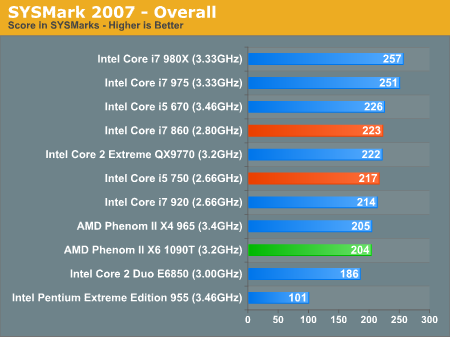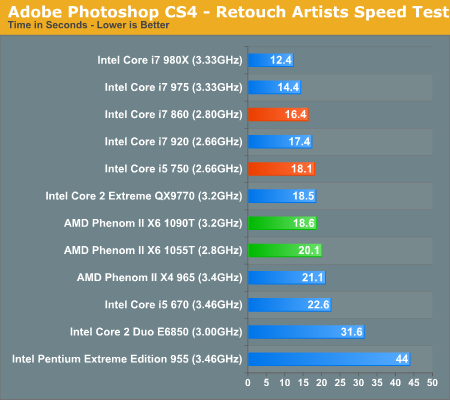AMD's Six-Core Phenom II X6 1090T & 1055T Reviewed
by Anand Lal Shimpi on April 27, 2010 12:26 AM EST- Posted in
- CPUs
- AMD
- Phenom II X6
SYSMark 2007 Performance
Our journey starts with SYSMark 2007, the only all-encompassing performance suite in our review today. The idea here is simple: one benchmark to indicate the overall performance of your machine.
SYSMark really taxes two cores most of the time, giving the edge to Lynnfield and its aggressive turbo modes. Lightly threaded or mixed workloads won't do so well on the Phenom II X6.

Adobe Photoshop CS4 Performance
To measure performance under Photoshop CS4 we turn to the Retouch Artists’ Speed Test. The test does basic photo editing; there are a couple of color space conversions, many layer creations, color curve adjustment, image and canvas size adjustment, unsharp mask, and finally a gaussian blur performed on the entire image.
The whole process is timed and thanks to the use of Intel's X25-M SSD as our test bed hard drive, performance is far more predictable than back when we used to test on mechanical disks.
Time is reported in seconds and the lower numbers mean better performance. The test is multithreaded and can hit all four cores in a quad-core machine.

Performance here is good, but even Photoshop doesn't make consistent enough use of all six cores to really give the Phenom II X6 the edge it needs here. It's faster than the Phenom II X4, but not faster than the Core i5 750.










168 Comments
View All Comments
Scali - Wednesday, April 28, 2010 - link
I think people buying an Extreme Edition CPU know exactly what they're getting themselves into.Those CPUs are never good price/performance, you pay a premium to get the absolute fastest CPU on the market, that's the whole point of the Extreme Edition concept.
Obviously Intel isn't going to offer only one expensive 32nm six-core forever. Perhaps this X6 CPU will trigger Intel to release more 'mainstream' six-cores and other 32nm CPUs.
JGabriel - Tuesday, April 27, 2010 - link
For home use, yes. For professional use, that 48.8 frames/second on the 980x vs. 28.5 on the 1090T, for x264 2nd pass encoding, looks quite justifiable. If that's your business, that'll pay for itself in a couple of weeks..
pjconoso - Tuesday, April 27, 2010 - link
Point taken. I was speaking for home users. ;)pow123 - Wednesday, May 5, 2010 - link
Exactly. A few seconds. I will not pay for an over priced processor for a few seconds. Keep it coming AMD.Lolimaster - Tuesday, April 27, 2010 - link
Watch tom's reviewhttp://www.tomshardware.com/reviews/amd-phenom-ii-...
More justice to the AMD cpu's. Just pass the synthetic intel compiler bugged benchmarks.
haplo602 - Tuesday, April 27, 2010 - link
Actualy the results are what I expected and what was also explained in the review. Not stellar, but very good for the money spent ...I guess I'll buy one of the 4-cores.
Hacp - Tuesday, April 27, 2010 - link
Anand, why do you not try to push the chip on overclocking? Also, why not do an I7 overclocked vs Phenom X6 overclocked performance comparison? Overall, I feel that this review was pretty limited and unenthusiastic for such an exciting product.ymetushe - Tuesday, April 27, 2010 - link
Second this. I was really hoping you'd do some overclocked benchmarks, say at 4GHz, so that we could see clock for clock performance of 6 Thuban cores vs. 8 Bloomfield/Lynfield threads.JGabriel - Tuesday, April 27, 2010 - link
Check the x264 and Cinebench results. Clock for clock, at 2.8 Ghz, two hyper-threaded Lynnfield cores seems to match three Thuban cores - at least for rendering & encoding purposes..
Anand Lal Shimpi - Tuesday, April 27, 2010 - link
I try to provide a look at what sort of headroom you can get out of the chip while feeding it as little voltage as possible. The idea is to keep power consumption at a minimum while increasing performance. I found that the jump from 3.8 to 3.9GHz required quite a bit of additional voltage, while just going to 3.8GHz was basically a non-issue - which to me is more impressive than trying to squeeze another 100 - 200MHz out of the chip.Take care,
Anand